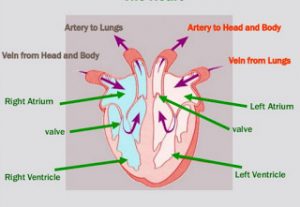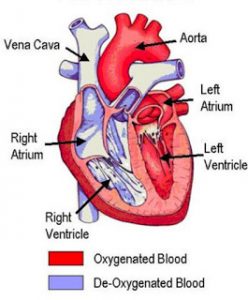Question 1 Name the largest artery in our body?
Question 2 What is the meaning of double circulation?
Question 3 Explain the double circulation of blood in human heart?
Question 4 Describe the structure and function of human heart?
Question 5 What is cardiac cycle?
Question 6 Define the term systole?
Question 7 Define the term diastole?
Question 8 What is blood pressure?
Question 9 Name the instrument used to measure blood pressure?
Question 10 Define systolic pressure?
Question 11 Define diastolic pressure?
Heart
(1) It is a muscular organ, big as our fist, reddish brown in colour, situated between the 2 lungs in middle of thoracic cavity, surrounded by 2 layered sac.
(2) It has different chambers to prevent the oxygen rich blood from mixing with blood containing carbon dioxide.
(3) Heart is divided by septa into 2 halves i.e. the right and left. Each half consist of 2 chambers: upper atrium and lower ventricle. Thus heart has 4 chambers: Right atrium, left atrium, right ventricle, left ventricle.
(4) There are valves between left atrium and left ventricle and between right ventricle. These valves provide one-way passage and prevent return of blood.
(5) The valves of heart are made up of cardiac muscles.

The sequence of events which take place during the completion of one heart beat is called cardiac cycle.
It involves repeated rhythmic contraction and relaxation of heart muscles.
Contraction is called systole
Relaxation is called diastole.
(1) Oxygen rich blood from the lungs enter the left atrium. The left atrium relaxes when it is collecting the blood. Then it contracts while next chamber i.e. left ventricle expands so that blood is transferred to it.
(2) From left atrium the blood is transferred to left ventricle through bicuspid valve. From the left ventricle the blood is pumped to various parts of body through aorta(largest artery).Oxygenated blood from lungs enters the left atrium through pulmonary veins.
(3) The de-oxygenated blood from various parts of the body is poured into right atrium through large veins called vena cava.
(4) As the right atrium contracts, the corresponding right ventricle expands and blood through tricuspid valve gets collected. It then pumps it to the lungs for oxygenation by pulmonary arteries. In the lungs this blood become oxygenated and return to the heart by pulmonary veins.
The blood circulation in human heart is Double Circulation. This means that blood p asses through heart twice. One circulation involves entry of blood from all body parts to heart. This blood is deoxygenated which goes to lungs for oxygenation. The second circulation involves entry of oxygenated blood from lungs to heart and then to all body parts.
The force that blood exerts against the walls of a vessel is called Blood pressure.
It is measured by Sphymamometer.
The pressure of blood inside artery during ventricular contraction is called Systolic pressure.
The pressure of blood inside artery during ventricular relaxation is called Diastolic pressure.
It is 120mm of Hg /80mm of Hg

Good way to learn.
Nice
Thaks alot
it is very easy way to learn
You are great
my textbook explanation is too hard to study .but i found this so easy and relaxing.i was so tensed how to learn the defenition . now i found the good site to learn it ..thanks a lot …….
Thank you so much MAM
Thanks full for your ideas ☺️
Its really a very simple explanation of heart or the circulation in human body.Thank you for this awesome note.
Good….Helpful….
Easy way to understand
Thank you
Thanks alot
Thank you so much . It’s very easy to learn
Nicely explained
helped me!!!!
Thank you so much
Thanks a lot it is very helpfull
Thank You Very Much Mam ☺️
It helps me a lot
very well explained
Thank you..
Thanku
It really helps to much
Wowooooooo
Very helpful. Thanks a lot
This note is damn easy.. ncert’s note is quite hard to learn… thank you so much for the notes
Thank you for your help
It is very helpful for me and all
I felt very tough for me to learn heart question. I didnt properly listen to my teacher and felt this very tough. When i was searching for notes i found this website and I would tag this the best notes and very easy. Once i went through this notes i easily understood the concept. Thank you so much for such a easy notes. In guides and ncert it was very big and tough but this one is very small and easy.